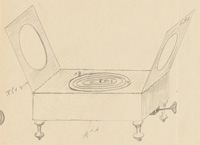The Antikythera Mechanism
Website of the Antikythera Mechanism Research Project: http://www.antikythera-mechanism.gr
The Antikythera Mechanism was a bronze gearwork device displaying chronological cycles and motions and phenomena of the heavenly bodies, made somewhere in the Hellenistic world in the second or early first century B.C. Fragments of it were recovered just over a century ago from the wreck of a Greco-Roman ship that sank, probably not long after 70 B.C., off Antikythera, a small island between Crete and the Peloponnese; since their discovery they have been preserved in the National Archeological Museum in Athens.

Through the work of many people, most notably Albert Rehm, Derek Price, Allan Bromley, Michael Wright, and researchers belonging to or collaborating with the Antikythera Mechanism Research Project, we currently have fairly secure understanding of a substantial portion of the inner workings as well as the outer displays of the Mechanism. Focuses of ongoing research include the inscriptions inscribed on the Mechanism's exterior, its date and provenance, possible lost gearwork simulating planetary motion, and the history of study of the artifact.